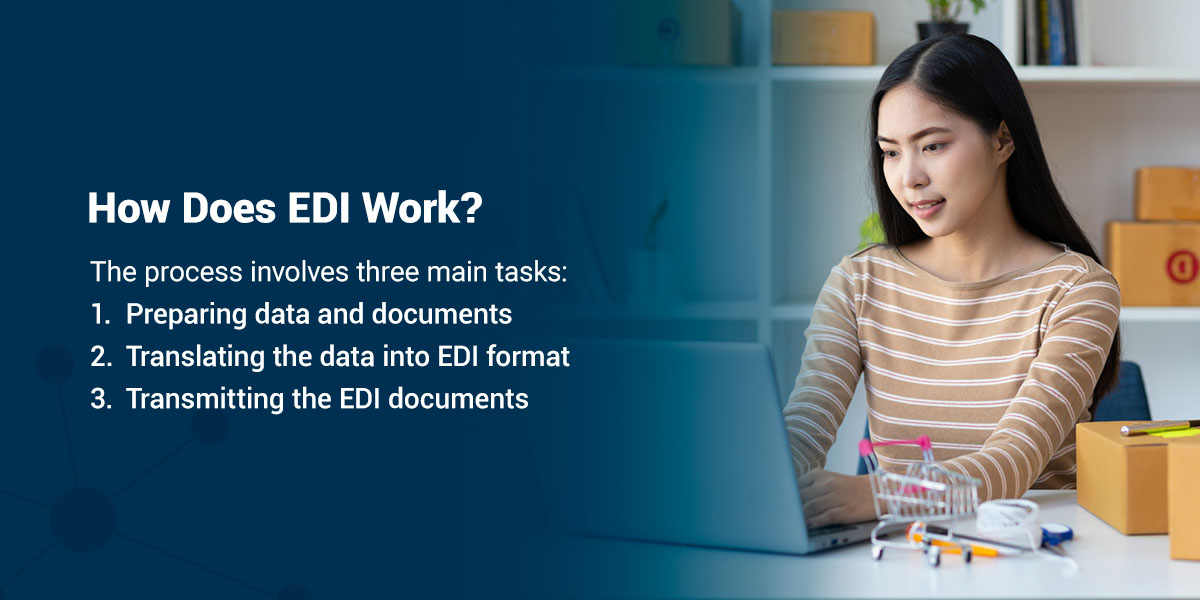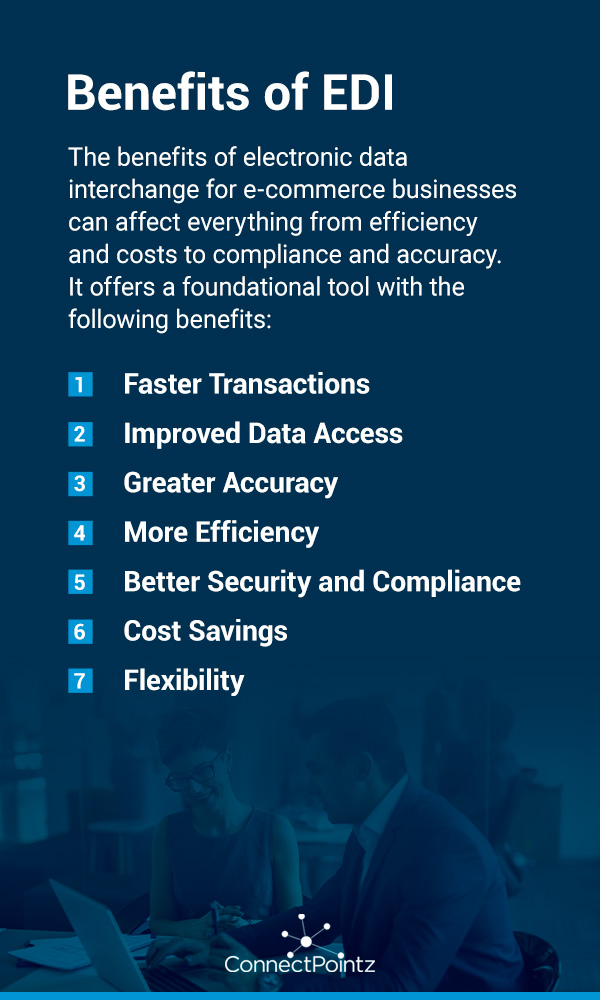
Electronically transmitting data is practically a prerequisite for today's e-commerce environment. The challenge lies in making those transmissions accurate and efficient. That's where electronic data interchange (EDI) comes in. EDI allows e-commerce businesses to exchange information automatically, with consistent formatting and reliability. You don't need a massive IT team to implement it, either. Even small- and medium-sized businesses (SMBs) can take advantage of EDI with the right system.
Let's take a closer look at the many advantages of EDI and what they can do for e-commerce businesses.
What Is EDI and Why Is It Important?
Electronic data interchange refers to a standardized system businesses use to transfer documents and information. Without EDI, everyone uses internal formats and systems. Communicating with other businesses would call for extensive resources to translate data into usable formats. For instance, a buyer might send a purchase order to a manufacturer. Upon receiving it, the manufacturer needs to translate the data from the document into something that makes sense to their in-house system. Then, the manufacturer might send an invoice back to the buyer, who needs to translate the data again.
When paired with manual processes, like scanning documents or transcribing data, these translation and transmission processes can be incredibly time-consuming. They're also prone to error. EDI systems don't eliminate the need for translation, but they can automate the process and eliminate or greatly reduce manual intervention. They use standardized formats for easy data exchanges across industries and partners.
Most of these formats are from the American National Standards Institute (ANSI), specifically ANSI X12. Outside of the United States, companies typically use the United Nations rules for Electronic Data Interchange for Administration, Commerce and Transport (UN/EDIFACT). Both frameworks offer specific codes and formats for different purposes. You can also find protocols for industry-specific demands, like RosettaNet for electronics and technology.
Many businesses use EDI to comply with the requirements of industry partners, like certain retailers, but they also use it to improve internal processes.

How Does EDI Work?
An EDI system depends on several different components, including translation software and a shared network with the two businesses communicating. The process involves three main tasks:
- Preparing data and documents: This first step might involve some manual entry or automated processes but simply requires building an electronic file with the information you mean to send. You could translate an internal file or create a new EDI document.
- Translating the data into EDI format: Next, the translation software in an EDI system will convert the data into a standardized format that other businesses' EDI systems can read. It uses common EDI codes that reflect the same information across EDI systems.
- Transmitting the EDI documents: With the translated document ready to go, the EDI system connects with the other business, usually through a direct connection or a network provider, also called a value-added network (VAN). It sends the document on its way and provides a notice to the sender to acknowledge the delivery.
The EDI platform itself can be quite varied and configured to suit the needs of your business. For example, some organizations will use direct EDI, also called point-to-point EDI, if they have a high volume of daily transactions with another business. These represent a more traditional approach to EDI and don't offer some of the benefits of more connected programs, like the ability to quickly communicate with businesses using other protocols.
A company that does more transactions with varying businesses might turn to a VAN, which makes use of a third-party provider's secure network. The third-party provider handles the different communication protocols to simplify the incoming and outgoing transmissions for the client. Yet another option is to use web EDI, which is more accessible to SMBs. It is more affordable and uses everyday web browsers to transmit and translate information. In short, businesses have many EDI strategies to choose from.
How EDI Works in E-Commerce
In the fast-paced e-commerce environment, EDI is crucial for facilitating speed and flexibility in operations. By automating the exchange of information between businesses, EDI ensures that data flows seamlessly between supply chain partners, buyers, and customers. This capability enables e-commerce businesses to quickly share critical information, such as inventory levels and order confirmations, while maintaining accuracy and reliability.
EDI can help you automate every step of the e-commerce landscape, particularly when communicating with other businesses and partners. While e-commerce might allow a customer to place an order with you, you can use EDI to automatically place an order with your supplier when your stock levels get low or submit documents required for compliance. EDI can also help with things like:
- Meeting your partners' requirements, such as submitting accurate advance shipping notices to a retailer.
- Complying with industry regulations.
- Making adjustments according to real-time events, like changing stock amounts.
- Simplifying onboarding processes for new partners and merchants.
- Ordering, paying for and invoicing various purchases.
- Generating quotes in response to customer requests.
Keep in mind that EDI and e-commerce aren't the same things, but they work together beautifully and can support end-to-end automation. EDI is particularly useful for companies that repeatedly work with the same partners, need to track fulfillment and shipments, and submit invoices and other accounting paperwork to businesses. It has many benefits for B2B operations, like real-time data availability and automated ordering.

Advantages of EDI
The benefits of electronic data interchange for e-commerce businesses can affect everything from efficiency and costs to compliance and accuracy. It offers a foundational tool with the following benefits:
1. Faster Transactions
Whether you're typing, scanning or handwriting business documents, these manual processes are slow. The act of entering data is tedious, and it adds time between when you need the data and when someone gets around to submitting it. For example, an order might go through at 6 p.m., after the office closes, so your employee wouldn't be able to submit the order until the next morning. This schedule can cause delays in fulfillment, availability and other business processes.
When you use automated EDI, you can greatly increase the speed of these transactions and minimize labor requirements associated with data entry. It allows you to better meet your customers' expectations for a fast, responsive shopping experience and ensure plenty of time to address problems, such as supply chain delays. Whether you're trying to improve internal processes or enable more positive customer experiences, EDI can help.
2. Improved Data Access
EDI can make it easier for employees, partners and customers to get the information they need. It eliminates the need to chase down files or spend valuable time typing in data. Since EDI enables real-time data sharing, users always know they're working with the most recent information. It could, for instance, offer more reliability for shipment tracking or order processing.
With EDI, you can also centralize your documents. A conventional system might lead you to store files in scattered locations, like different filing cabinets or computers in separate offices. An EDI system can centralize your data in one place, making it easy for everyone to get accurate, up-to-date information.
3. Greater Accuracy
Manual processes are inherently error-prone. The general rule of thumb is that humans will make errors about 1% of the time. That might not seem like much, but when you consider every single piece of information that goes through your system, 1% can add up. Even the best employees in the world are people, too. From stress and boredom to distractions and misunderstandings, many different factors can lead to errors during manual data entry.
Automated systems don't have this problem. They're far more accurate and can help you avoid costly mistakes. Better accuracy can mitigate problems related to:
- Quality control and correction activities: More errors call for more protections. Increasing accuracy may help you reduce the need for excessive quality assurance steps or labor required to fix problems.
- Your reputation: Inaccurate data can damage your reputation in ways that are hard to recover from. A dependable system can be invaluable.
- Business processes: Out-of-date or inaccurate information makes it harder for decision-makers to respond quickly. In fast-paced industries, these delays could have significant consequences.
4. More Efficiency
Unsurprisingly, all of that extra speed, accuracy and accessibility lead to more efficient business processes. You can avoid time-consuming, costly tasks associated with gathering data, entering it into your system and fixing errors. Instead of spending your resources on these activities, you can allocate them to more important tasks that bring more value to the business.
Rather than spending their day typing up invoices, you can set your team members on tasks that require the human touch or make use of their special qualifications. They'll be working at the top of their pay grade and leaving mundane, everyday tasks to the computers. While working more efficiently, this repurposing should help improve employee happiness since factors like variety, workload, autonomy and development opportunities are all crucial components of job satisfaction.
If you rely on physical recordkeeping, EDI can also offer more efficiency through a paperless system. You won't need to use up supplies like pens, paper and toner, and you can keep your data safer in an electronic environment. It's much harder to destroy or lose the information, especially if you keep it in the cloud.
EDI offers efficiency-boosting benefits in many different ways, helping you eliminate wasted time and resources in the business.
5. Better Security and Compliance
EDI offers a much more secure environment for your data, both at rest and in transit. The electronic landscape gives you a complete picture of your transactions, and EDI's automation capabilities can drastically reduce your risk for data breaches. The human element accounts for a whopping 82% of data breaches, as people can fall victim to social engineering scams, intentional misuse or everyday errors. EDI allows you to automate processes and reduce the potential for human errors.
A dependable EDI platform will also offer more security while transmitting information. It uses secure protocols and systems to send and receive information, helping to keep it safe from malicious actors and staying compliant with applicable industry regulations. EDI can also help you stay audit-ready, with clear records of all transactions in case the officials come knocking.
6. Cost Savings
All of these benefits can help you save significantly on many different costs, like labor and materials. Say goodbye to spending hours fixing manual data entry errors or tracking down a printed order. Working faster can help you gain an advantage over the competition, appealing to customers and helping you offer more satisfying experiences for customers and partners alike.
7. Flexibility
EDI offers valuable benefits for business agility. By allowing you to quickly communicate with partners and have real-time data at your fingertips, you can make decisions and changes much faster than the competition. If you need to scale up and add more partners, EDI allows you to onboard them in no time. If you want to shift gears with your shipping solutions, it requires minimal downtime or IT demands. Employees don't need to relearn data entry or spend valuable time implementing new software systems.
As your business evolves, EDI makes it easier to grow and change.

EDI Integration for E-Commerce
EDI has an especially helpful role to play in e-commerce. E-commerce businesses require a lengthy chain of partners, like online retailers, returns management systems, third-party logistics (3PL) providers and internal software solutions. Each one might use different formats and protocols, and many partners require EDI, especially large ones like Walmart and Amazon. These organizations have too much data passing through every day to use anything but automated, standardized systems. Any e-commerce company that wants to work with these retail giants must use EDI.
Of course, EDI offers benefits for those big companies, like minimizing labor requirements and improving organization, but it also helps the businesses looking to work with them. It provides a dependable way to communicate, so you don't need to worry about submitting documents with costly errors or causing problems that could damage your relationship with the company. It makes compliant communications simple and straightforward, offering peace of mind.
Plus, with so many partners, it can be hard to see how information comes together and leads to actionable insights. EDI's translation software connects everyone in the chain, converting data between internal formats and generic EDI formats so you can communicate with anyone and bring them into the fold of your automated solutions. Whatever you want to do with your data, EDI allows you to adapt and evolve. It's an essential part of e-commerce in the modern, omnichannel sales environment.
Start Integrating With EDI Solutions From ConnectPointz
EDI can get complex, but ConnectPointz makes it simple, no matter how large or unique your business is. We offer a wide range of EDI integration services to accommodate your e-commerce environment and deliver all of the benefits we've discussed. From cost savings to speed and flexibility, ConnectPointz EDI solutions can revolutionize your approach to data management and open up new possibilities for future partnerships and interactions with other businesses.
Explore our integration services to learn more about how ConnectPointz can help, or reach out today to discuss EDI with a representative!










































